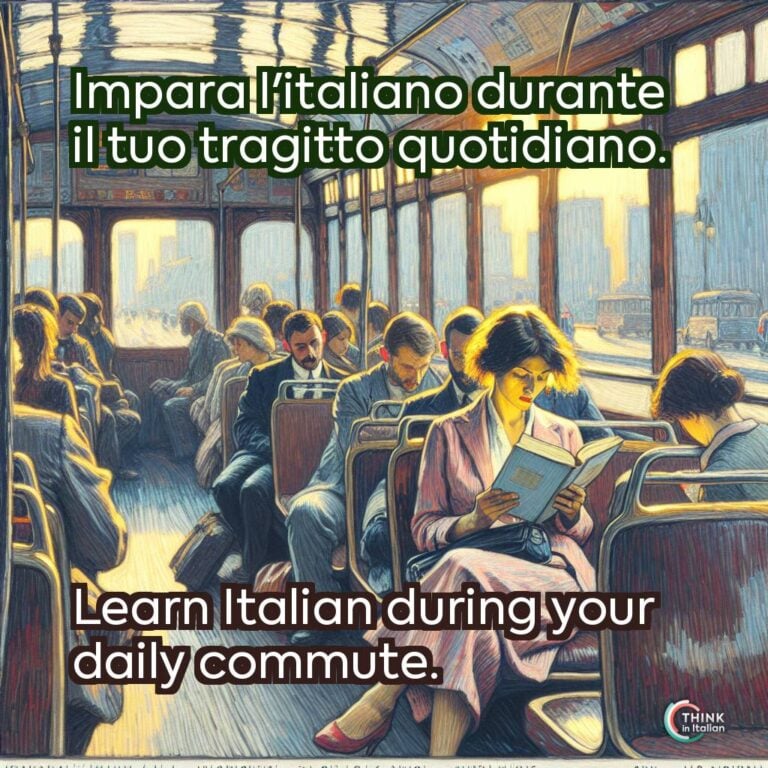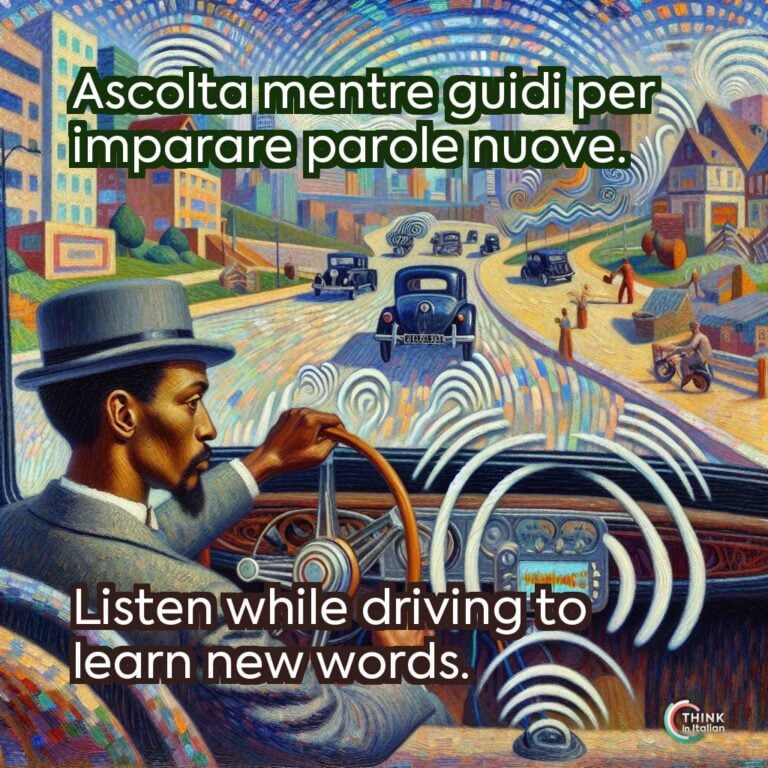Why Should I Learn Italian in the Car?
When I was living in Italy, I used to spend a significant amount of time driving each day, just like many of you. I do like driving, but I always felt that it was wasted time. Then I realized I could invest this time to do something: learning a new language.
If you find it challenging to cut yourself some time to learn Italian vocabulary, think about how much time you spend commuting every day. Whether by car, bus, or subway, these moments provide a unique opportunity for language immersion.
Research from the American Automobile Association (AAA) Foundation for Traffic Safety indicates that the average American spends about 51 minutes a day driving, nearly six hours a week! Imagine if you could use this time to learn Italian.
Let me show you the best ways to learn Italian in the car: I’ll dive into what research says about this, I’ll tell you some personal experiences, and I’ll compare different methods.
What Are the Best Methods to Learn Italian in the Car?
Audio Courses
Audio courses like “Ripeti con me!” are designed specifically to learn languages while doing something else; something repetitive like cooking, driving, cleaning. They focus on active recall and repetition, which helps with both listening and speaking skills.
For me, a person who gets bored when doing only one thing at a time, this is the best and most engaging way to learn languages because it forces me to speak out loud and think in Italian.
According to research published in the Journal of Memory and Language (2020), combining passive listening with active recall can improve vocabulary retention by up to 70%. This makes audio courses particularly effective.
“Ripeti con me!” uses a three-part audio approach: listening, repeating, and shadowing, which not only keeps you engaged but also ensures you are actively producing Italian speech rather than just passively listening.
Language Learning Apps
Language apps are popular for their structured audio courses. They are an easy, accessible, and flexible way to learn languages, especially for beginners and intermediate learners.
They allow you to incorporate language learning into your daily routines. In fact, according to the American Council on the Teaching of Foreign Languages (ACTFL), 64% of users use language apps while commuting or during short intervals.
Whether language apps work or not really depends on your aim: in my experience, they are very useful to practice grammar and vocabulary. But if you are looking for the best app to learn Italian, have a look at our Italian language app review!
Language Learning Audio Content
If you love podcasts as I do, then make good use of them to learn Italian as well. These resources often include cultural notes and informal language, which helps provide context.
They are generally more about passive listening than active learning, and that’s why they are found to be most effective when combined with more interactive learning methods.
Scientific Insights on Learning Italian in the car
Effectiveness of Auditory Learning
Research shows that auditory learning, especially in language acquisition, is highly effective. However, not all types of audio content can be done any time.
Listening to audio content that requires minimal cognitive load (like familiar phrases or vocabulary) can be done safely while driving, while learning that requires high levels of concentration or decision-making can interfere with driving performance.
For this reason, I recommend starting with simpler lessons while driving and saving more complex grammar exercises for a time when you can fully focus.
Multitasking and Cognitive Load
Learning a language while driving involves multitasking, which, when done correctly, can enhance efficiency and reinforce learning.
Integrating language learning into your daily routine will provide you with a boost in motivation and consistency. This happens because you will link the action of driving to learning Italian, and you will not do without it.
Also, if you feel stressed and anxious about learning Italian, multitasking can create a more relaxed, informal learning environment, making it feel less like a formal study session and more like an everyday habit.
Safety Considerations
I do want you to learn Italian fast, but I also want to make sure you all are safe, always. It is well known that distractions can increase the risk of accidents as they slow reaction times by up to 30%. Therefore, it’s essential that the audio content that you listen to matches the driving environment.
This is why “Ripeti con me!” is perfect: it provides you with easy and familiar content that can be effective during high-traffic situations.
How to Learn Italian in the car
One thing I’ve learned over the years is that no single method works for everyone: we all have different learning styles. Here’s how you can tailor your learning based on your style:
- Visual learners: if you’re a visual learner like I am, you might find it helpful to pair audio lessons with visual reviews. After driving, review vocabulary using flashcards or language apps with pictures.
- Auditory learners: if you’re an auditory learner, you’re lucky. Audio courses like “Ripeti con me!” are perfect for you. Repeating after the audio and mimicking intonation can significantly boost your retention.
- Kinesthetic learners: for kinesthetic learners, incorporating movement or gestures can help. Of course, you should limit this while driving! But you can do so at home or work to complement your auditory learning.
- Reading/writing learners: if you prefer reading and writing, try combining your audio lessons with written exercises. After a session, write down new words or phrases you learned and use them in sentences. This helps reinforce what you heard.
Personalize Your Time
Learning Italian in the car can be a game-changer if done correctly. The key is to find a method that suits your learning style, while staying safe, and keeping the motivation and consistency. Start small, set realistic goals, and gradually build up your skills.
Don’t let your commute be just “dead time”: turn it into an opportunity to immerse yourself in Italian and get closer to fluency. And remember, learning a language is a journey, not a destination—enjoy every moment of it!






